Rome is known as the “Eternal City” due to its rich history and legacy that has endured throughout the centuries. The city was founded in 753 B.C. by Romulus and Remus -according to legend- and has been the center of power, culture and religion at various times. The term “Eternal City” originated at the time of the Roman Empire, when the city was in full expansion and the belief that Rome would last forever was consolidated. The Latin poet Albius Tibullus coined the expression “Urbs Aeterna” (eternal city) in his book Elegies.
Of the great European capitals I have visited, Rome has impressed me with its cultural exuberance. Literally any cobblestone has epics to tell us if we pay enough attention to it. Paris, London or Madrid itself are unparalleled in terms of “concentrated” cultural wealth: the British Museum, the Louvre or the Prado are singularities in the fabric of space-time that transport us to other times when we visit them. But in addition to the Vatican Museums, in Rome culture is “scattered”, if I may say so. It is non-stop. This undoubtedly has to do with the several centuries of advantage that Rome has over these other capitals in terms of relevance at the “world” level. I suppose that Cairo or Baghdad must also generate that impression.

Rome began as a small city-state in the central region of the Italian peninsula. Over the centuries, the city grew in power and territory, changing from a monarchy to a republic in 509 BC. During the Roman Republic, Rome expanded its influence throughout what is now Italy and beyond, thanks to a series of military victories, strategic alliances and a system of government that, although initially republican, gradually centralized around figures such as Gaius Julius Caesar. In 27 BC, Caesar Augustus became the first emperor, marking the beginning of the Roman Empire.
The Roman Empire reached its peak in the 1st and 2nd centuries AD, extending its dominion from the British Isles to North Africa, and from Hispania to Asia Minor. However, over time, the empire began to face internal problems, such as economic crises, barbarian invasions and power struggles. In 476 AD, the Western Roman Empire fell due to pressure from Germanic peoples, while the Eastern Roman Empire, known as the Byzantine Empire, lasted until 1453.
Trastevere
Trastevere is a picturesque neighborhood of Rome, known for its bohemian atmosphere, narrow cobblestone streets, and lively nightlife. It is located south of the Tiber River, in the western part of the city, and its name, which comes from the Latin “trans Tiberim” (beyond the Tiber) indicates that it is on the other side of the river from the city center. My dear friend JLLV hosted us in his apartment and played Cicero when he had the chance.
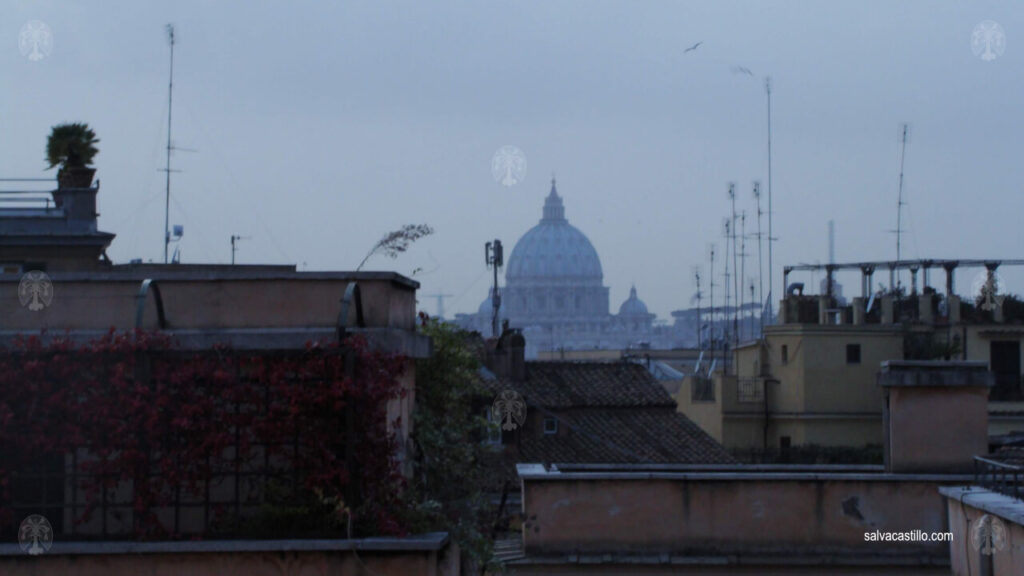
The dome of St. Peter’s Cathedral of the Vatican dominates the skies of Rome. Around a corner one comes across beautiful pictures that make Rome a city of nooks and crannies.

Walking the Old City Center
Via Giulia is one of the most elegant and emblematic streets in the historic center of Rome, built in the sixteenth century under the papacy of Julius II, who commissioned the creation of this road to improve circulation in the city and beautify the area. The street was designed by the architect Antonio da Sangallo the Younger and is known for its Renaissance style, with palatial buildings of great prestige, elegant facades and a rectilinear layout that contrasts with the winding and more chaotic streets of Rome. One of the highlights of Via Giulia is the Farnese Arch, a small and beautiful triumphal arch dating back to the 16th century. This arch was built in honor of Pope Paolo III Farnese, who belonged to the powerful Farnese family, one of the most influential families in Rome during the Renaissance.

The Temple of Juturna (in Italian, Tempio di Giuturna) is an ancient Roman temple dedicated to Juturna, the goddess of fountains and springs. It was located in the Roman Forum, near the Forum Lake, southwest of the Curia (the building where the Senate and the Roman magistrates met), in an area that was related to water and water resources of the city.
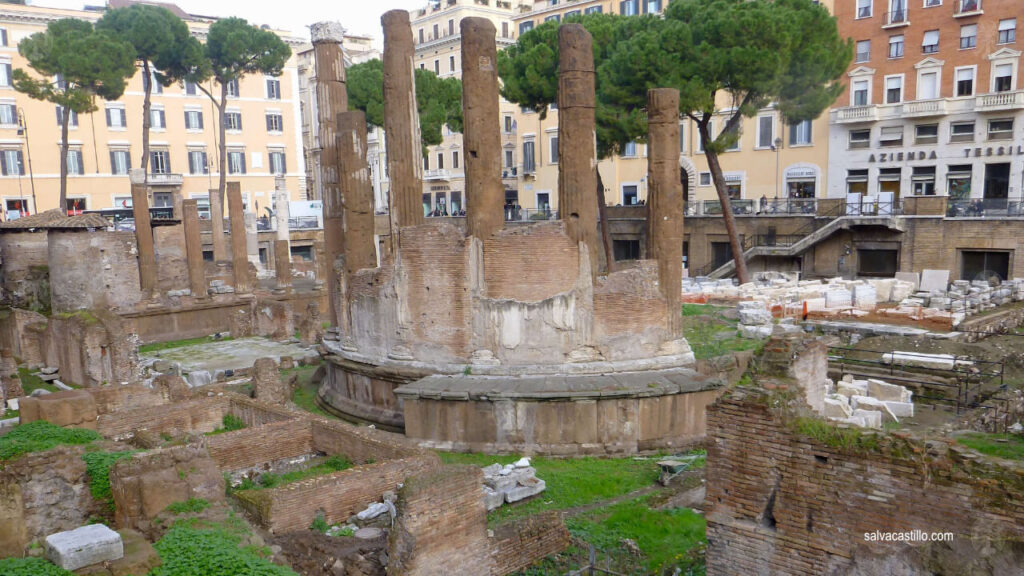
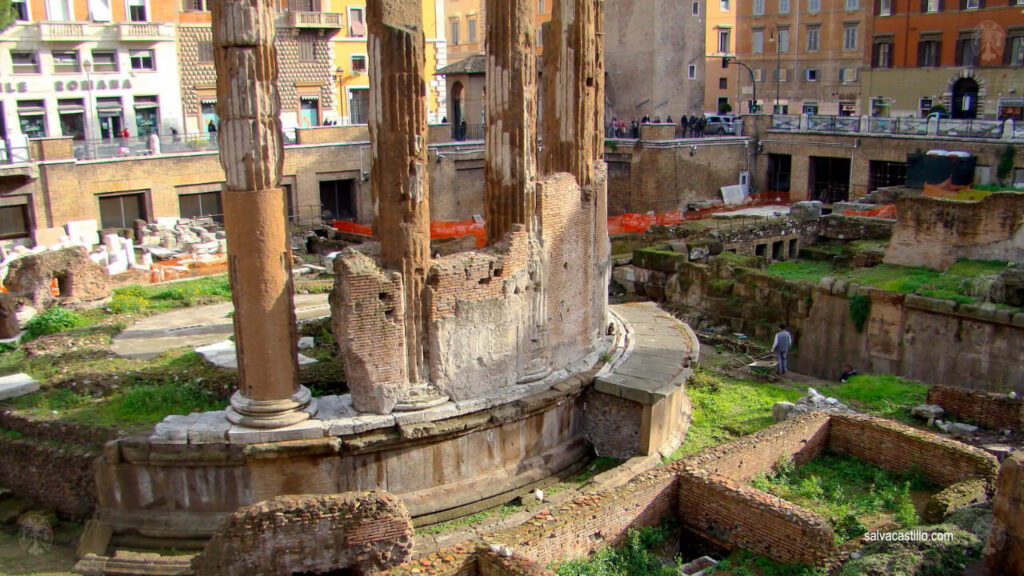
Campo de’ Fiori is one of the most famous and vibrant squares in Rome, known for its open-air market and lively atmosphere. It is located in the heart of Rome’s historic center, near the Trastevere district.


In the center of the square stands a statue of Giordano Bruno, a 16th century Italian philosopher and priest who was burned at the stake by the Inquisition in 1600 because of his heretical ideas. The monument is a symbol of freedom of thought and the fight against religious intolerance. The statue of Bruno, facing the Vatican, is a reminder of his tragic fate and his defiance of the ecclesiastical power of the time.
Castel Sant’Angelo
The Castel Sant’Angelo (Castel Sant’Angelo) is one of my favorite monuments in Rome. Aesthetically it is a beautiful crenellated castle and its circular plan makes it unique to the eye.

Located on the banks of the Tiber River, near the Vatican, its history and architecture have transformed this building into a mixture of fortress, papal residence and museum.

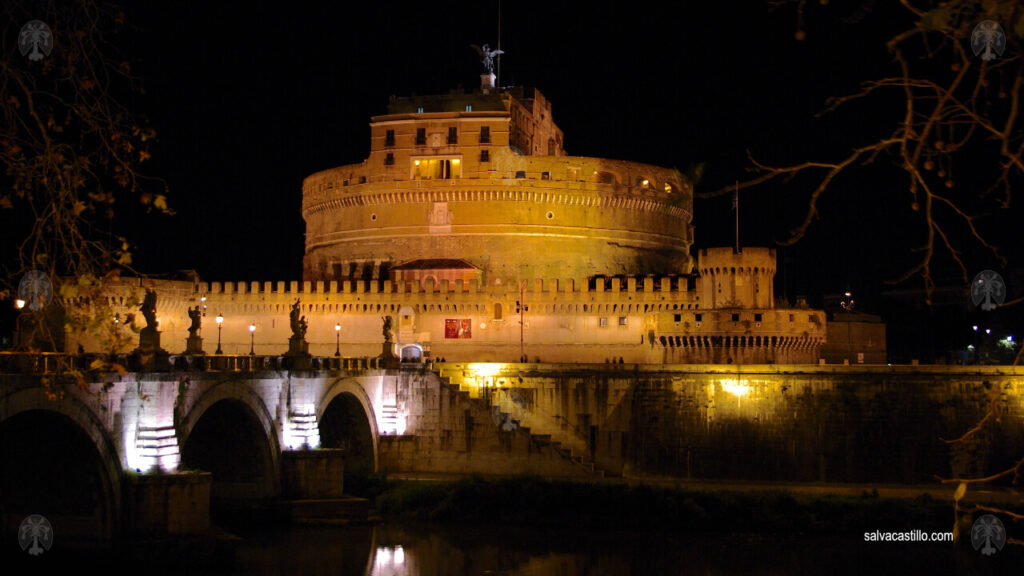
Originally, the building was designed as an imperial mausoleum for Emperor Hadrian and his family in 135 AD. The Ponte Sant’Angelo was originally built in 134 AD.
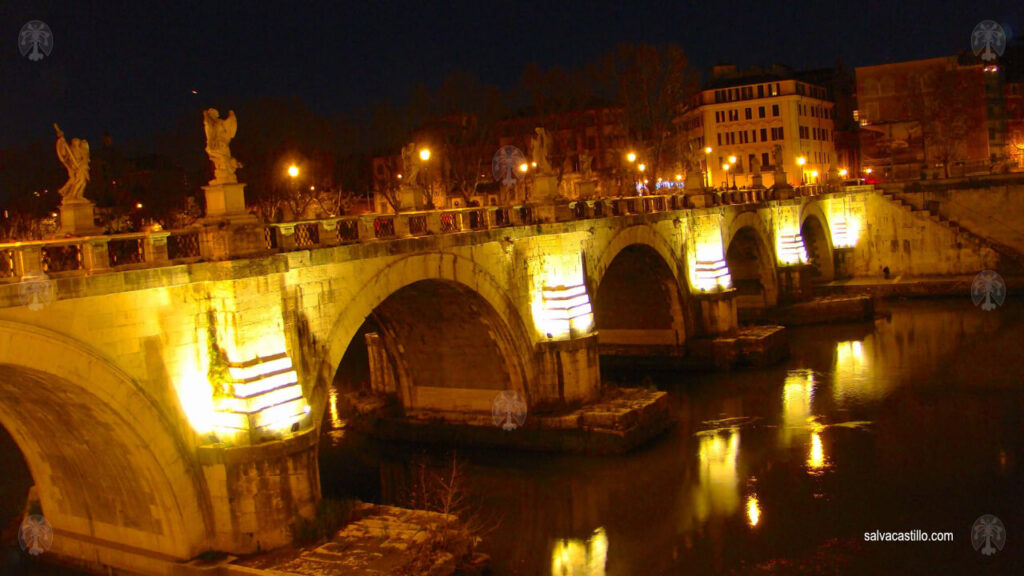
During the Renaissance, the bridge was renovated and embellished, especially in 1669 under the papacy of Clement IX. It was at this time that the 10 statues of angels, the work of prominent sculptors of the time, such as Lorenzo Ottoni, Bernini and others, that adorn the bridge were added. These statues represent angels holding different elements of the passion of Christ, such as the cross, the nails or the crown of thorns.
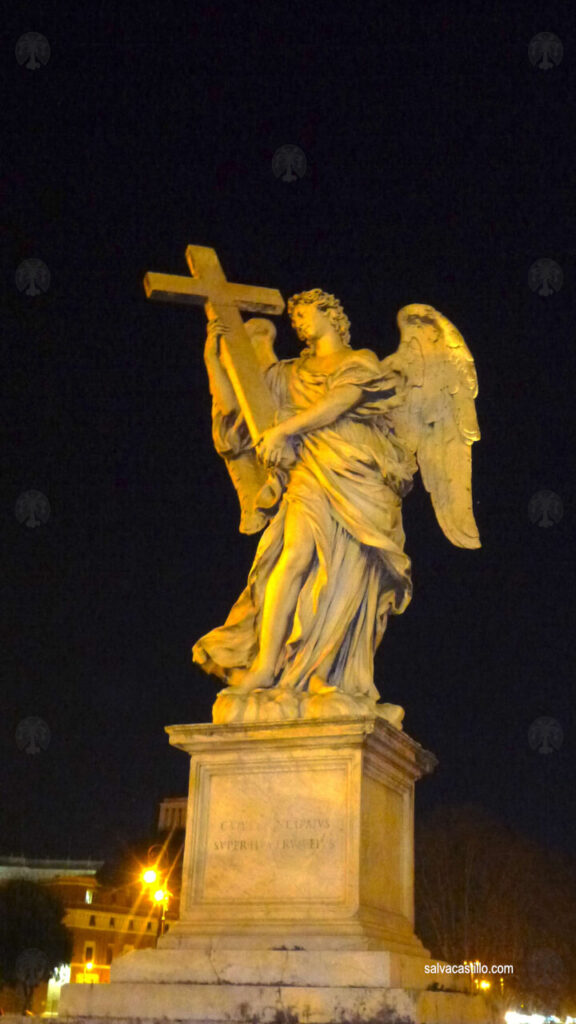
The name “Castel Sant’Angelo” comes from a 6th century legend, according to which Pope Gregory I had a vision of the Archangel Michael above the castle, who, spreading his wings, announced the end of the plague that was ravaging Rome. This vision was interpreted as a sign of divine protection, and the castle was renamed “Castel Sant’Angelo” in honor of the Archangel Michael.

In its original phase, the mausoleum had a circular plan (cylindrical in shape), with a large square base surrounded by a circular wall and a series of columns. This plan was typical of Roman imperial tombs.

Over the centuries, especially during the papacy of Gregory I in the 6th century, the castle was modified to serve as a military fortress.

The building was fortified and turned into a papal refuge, with the addition of exterior walls and defensive structures. Inside there are several passages and corridors with ramps to allow the rapid movement of troops and weapons.


The parade ground houses several sculptures and a huge crossbow -like the dragon slayers that appear in Game of Thrones 😉-.

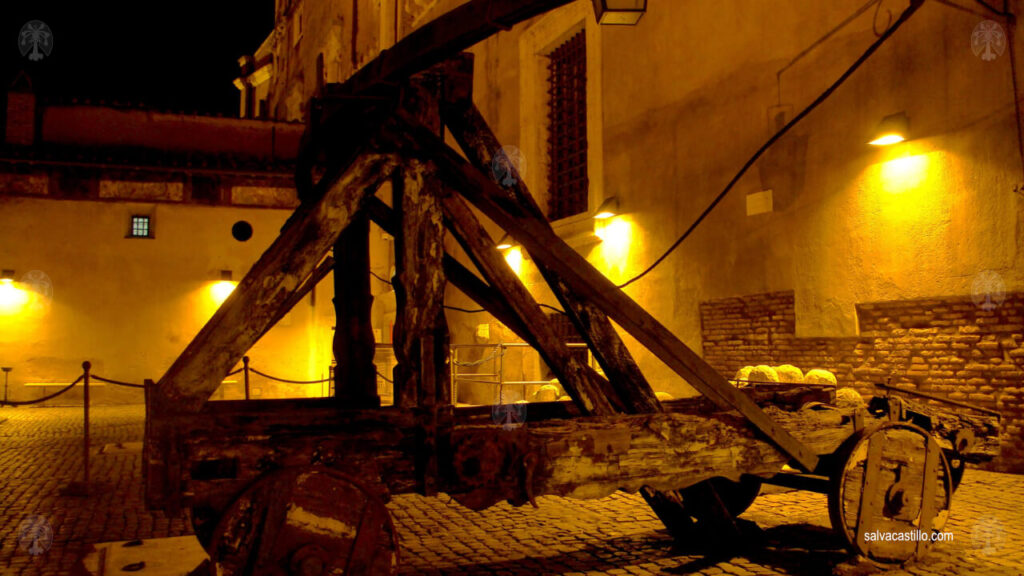
In the Museum of Castel Sant’Angelo I saw an exhibition of Renaissance weapons with delicate carvings. Some of these weapons are ceremonial, and sometimes belonged to the Swiss Guard – the Pope’s traditional protective guard.
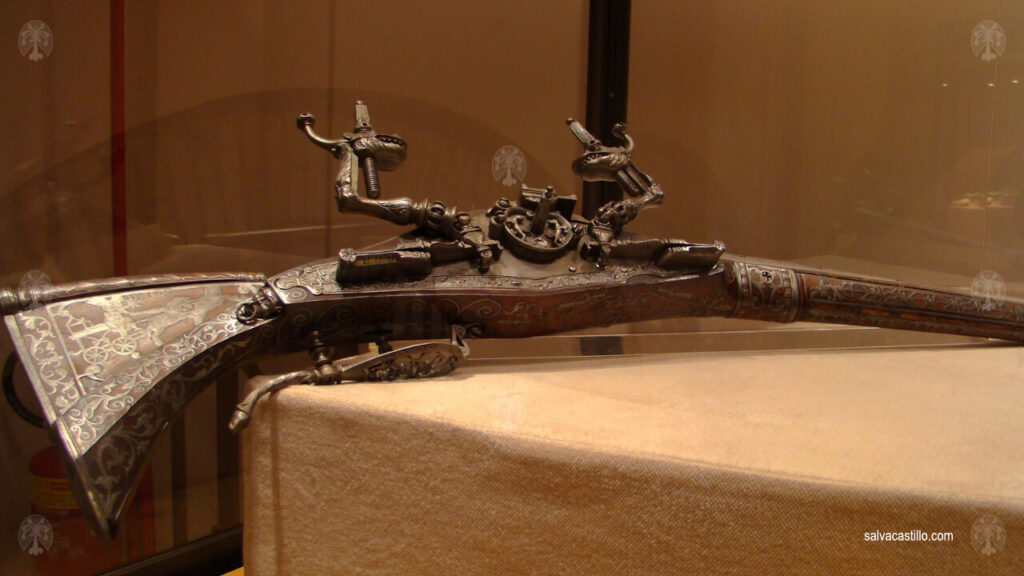
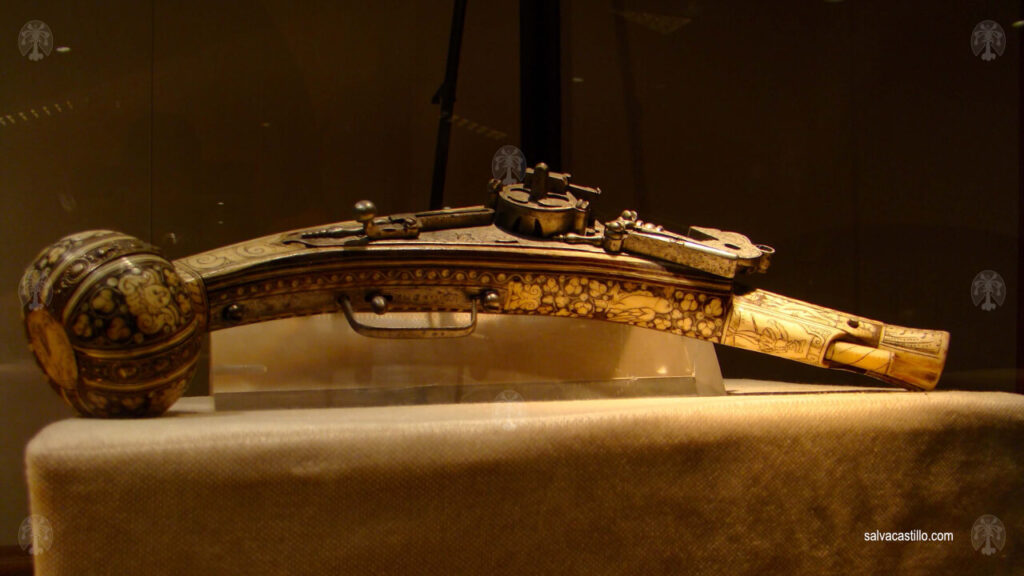
Inside the Castel Sant’Angelo are the remains of Hadrian and his successors, including the Empress Sabina. In its early years it served to house the remains of the members of the Antonine dynasty.

In the Urn Hall, you can see several funerary urns that were used to keep the ashes of the emperors and other members of the imperial family. These urns were decorated with motifs and sculptures representing the imperial glory and power of the dynasty. The use of urns was a Roman tradition for the treatment of the remains of emperors and important figures.

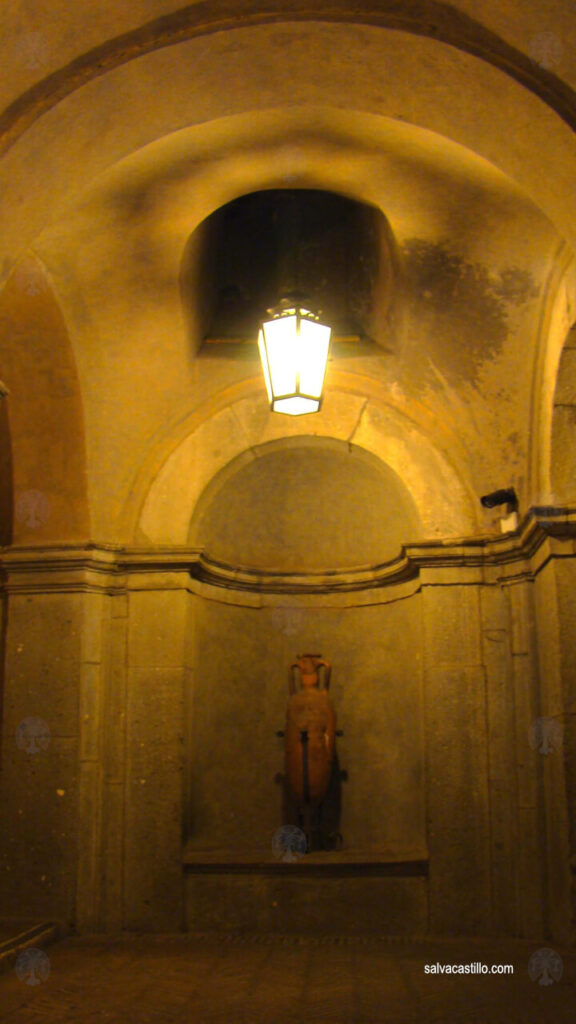
From the top floor there is a beautiful view of Rome.
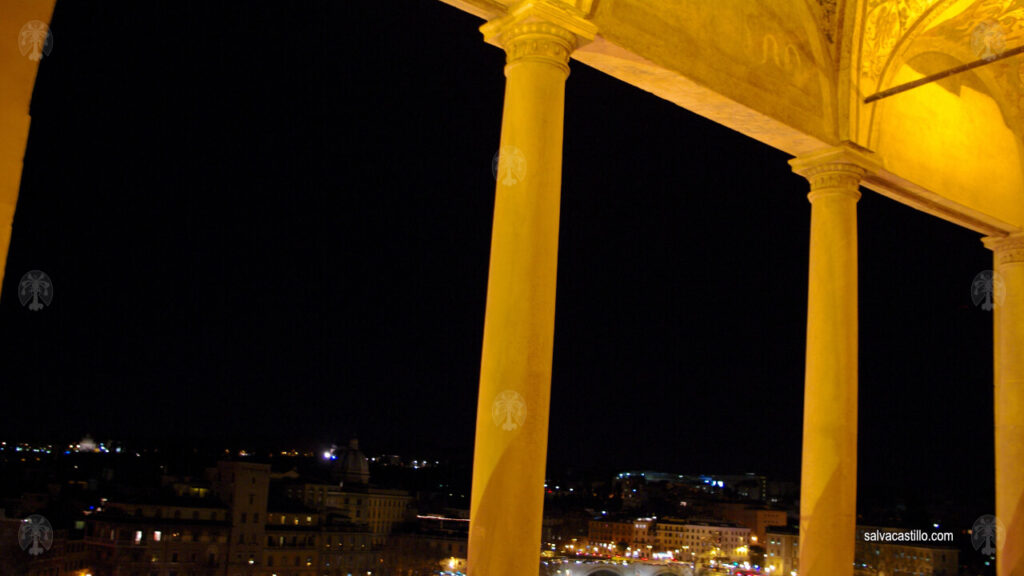


Castel Sant’Angelo has a direct connection to the Vatican through a subway passage known as the Passetto di Borgo. This passage, which was built in the 16th century, is one of the most fascinating elements of the castle’s history. It was a security measure for the popes, who, especially during periods of conflict and crisis, needed a quick and safe means of escape from the Vatican to the fortress.
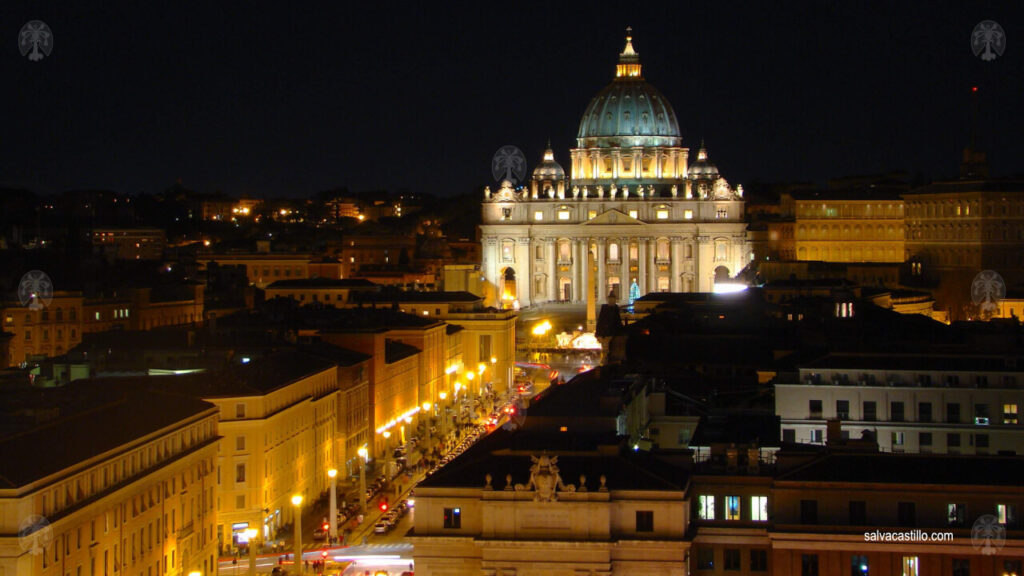
The terrace of the castle, where the statue of the Archangel Michael is located, offers a spectacular panoramic view of Rome, including St. Peter’s Square, the Vatican, the Tiber River and other emblematic parts of the city. It is accessed by a narrow passage of stairs.

The statue of the Archangel Michael with a sword symbolizes the protection of Rome and the Papacy.

Through this figure, the archangel is associated with the power of the papacy to defend Rome and its inhabitants, especially in times of crisis or invasion.
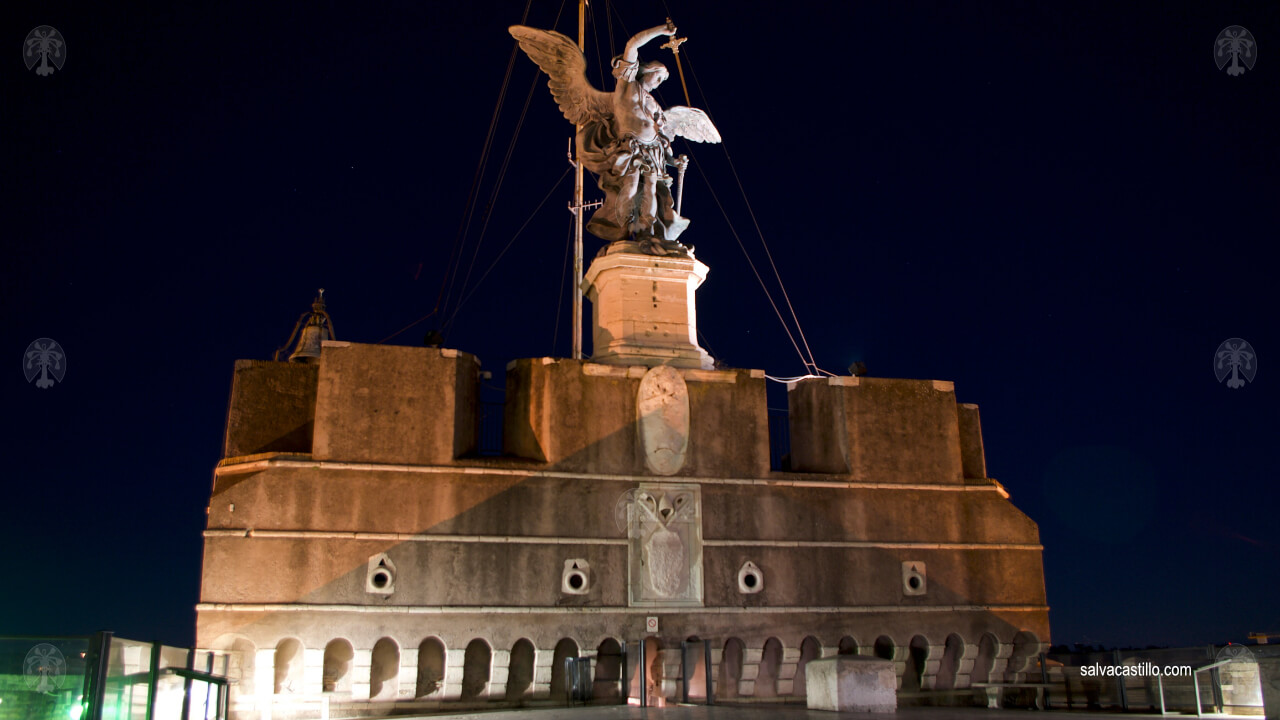
This moment of seeing the statue of St. Michael on a clear night, when the flow of tourists – by chance – on the terrace had momentarily ceased, is a great moment in my life.
Arco de Constantino
The Arch of Constantine was inaugurated in 315 AD to commemorate the victory of Constantine I over Maxentius in the battle of the Milvian Bridge (312 AD), which consolidated Constantine’s power as emperor.
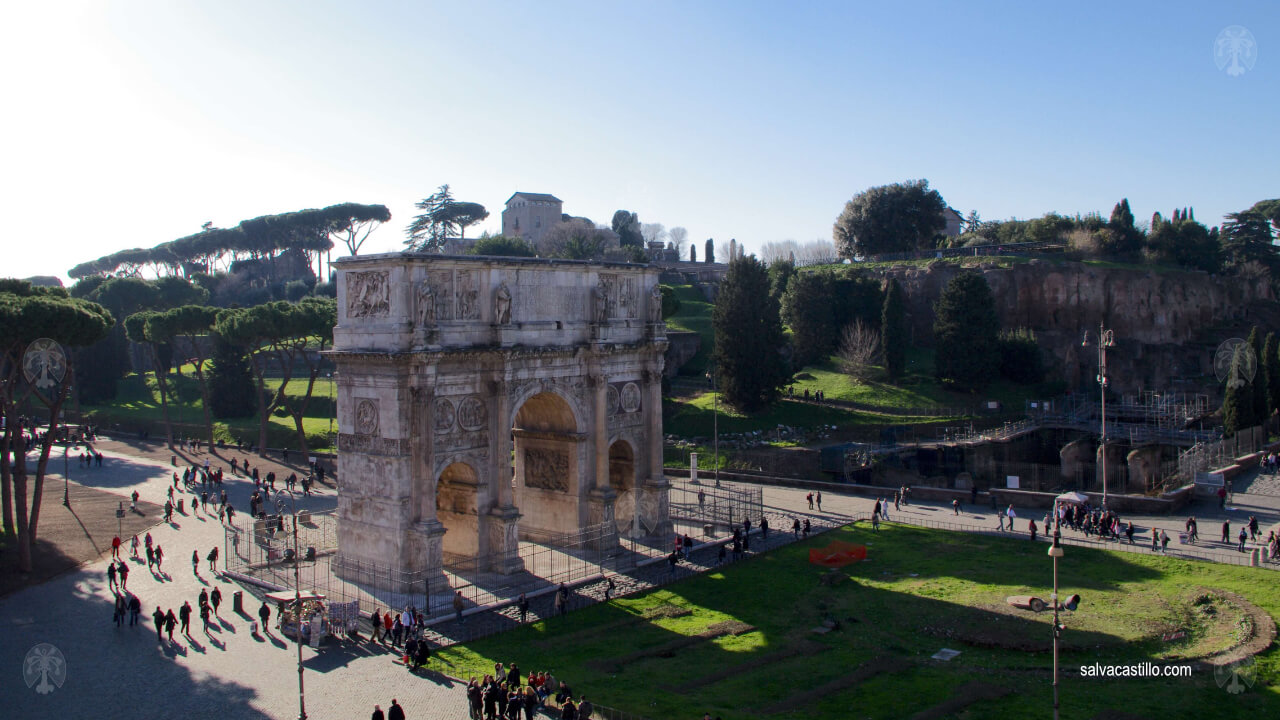
This victory was key, as it marked the beginning of the conversion of the Roman Empire to Christianity under the Edict of Milan in 313 A.D., which guaranteed religious freedom throughout the empire.

The panels of the arch are decorated with sculptural reliefs depicting scenes of Constantine’s victory over Maxentius, including battles, triumphal processions and scenes of Constantine’s acclamation as emperor.


The arch is strategically located between two of Rome’s most important monuments, the Colosseum and the Palatine Hill, and is one of the largest triumphal arches in the city. The arch is 21 meters high, 25.7 meters wide and 7.4 meters deep.

Near the Arch I found a group of soldiers of the Imperial Army of Rome doing parodic representations, very funny.
Trajan’s Column
Trajan’s Column (in Italian, Colonna Traiana) is one of the most important monuments of ancient Rome and stands as a symbol of the greatness of the emperor Trajan and his military success. It is located in the Forum of Trajan, in the heart of ancient Rome, near today’s Piazza Venezia.

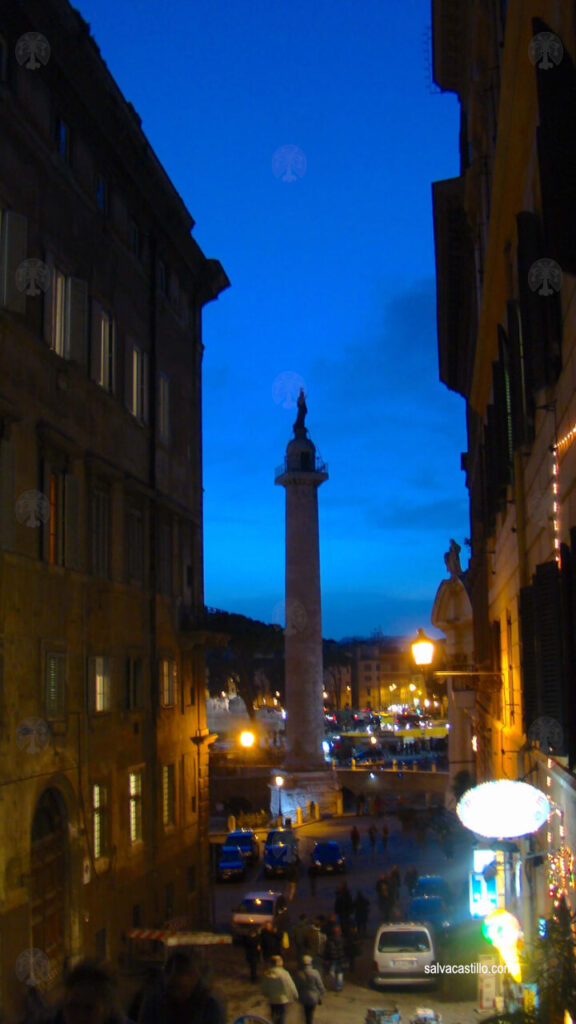
The column was erected in 113 A.D., by order of Emperor Trajan, to commemorate his victory in the Dacia Wars (101-102 and 105-106 A.D.), which were fundamental for the expansion of the Roman Empire in the region of Dacia (now part of Romania).
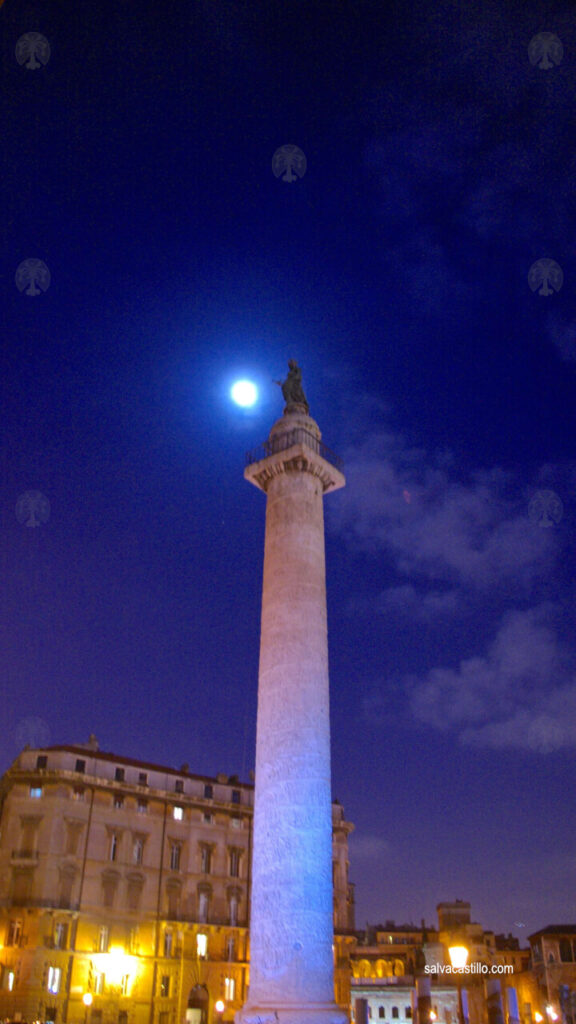
The most distinctive feature of Trajan’s Column are the continuous reliefs that cover its surface, which recount Trajan’s military campaign in Dacia. The relief begins at the base of the column and spirals up to the top, in a frieze 200 meters long, and is composed of approximately 2,500 figures.

The column has a height of 38 meters from base to top. It is built in Carrara marble, one of the most appreciated materials of the time. At the base of the column is a sarcophagus containing the remains of Trajan.
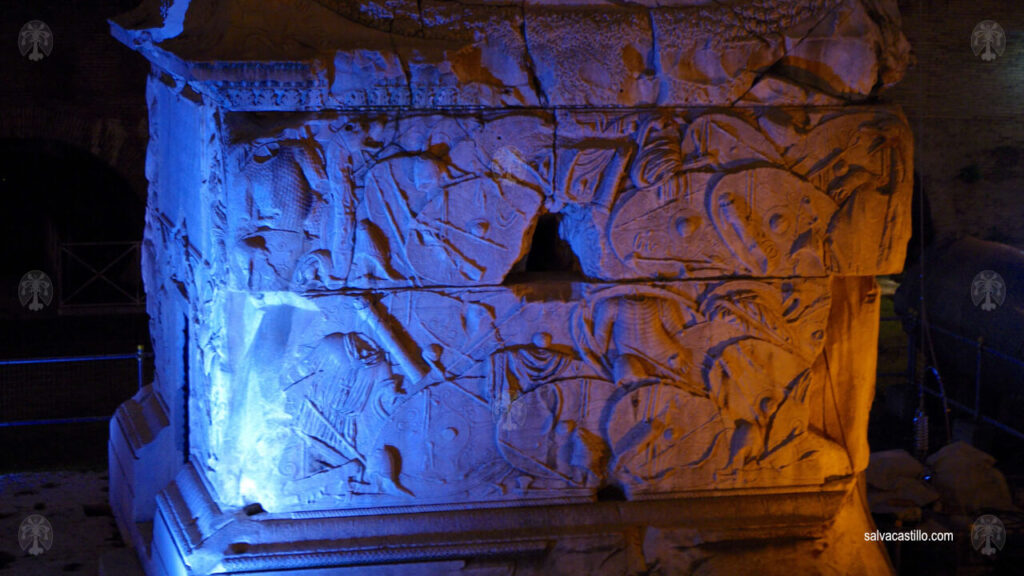
Roma and the Tiber river
The Tiber River (in Latin, Tiberis) is one of the most important geographical elements of the city of Rome and has played a crucial role in both the founding and historical development of the capital of the Roman Empire.
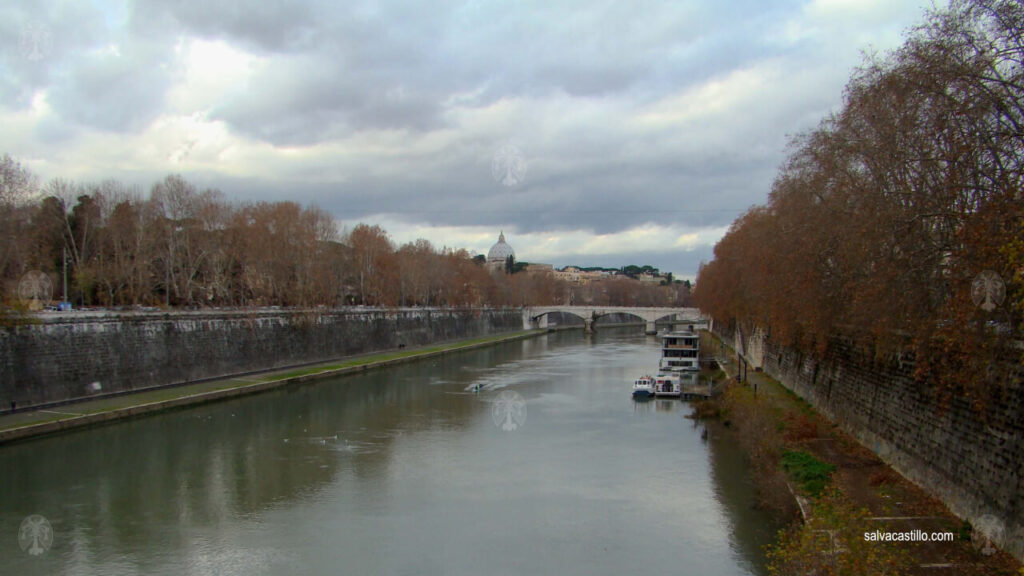
According to Roman legend, Rome was founded by Romulus and Remus, the mythical twins who were suckled by a she-wolf on the banks of the Tiber. This story is associated with the Palatine Hill, one of Rome’s seven mountains, which lies right next to the river. In Roman mythology, the river was associated with the god Tiberino, who personified the river itself. The Romans worshipped Tiberinus as a protective deity of the city, and his cult was especially important during the early centuries of the Republic. Intrinsically associated with the river, which meanders through the city, are its bridges.
Giuseppe Mazzini bridge: inaugurated in 1906 and dedicated to this important Italian politician, philosopher and activist, one of the main leaders of the Italian unification movement and defender of republican and democratic ideals.

Vittorio Emanuele II bridge: connects the Vatican district with the city center. Inaugurated in 1911, its construction was carried out to commemorate the first king of Italy, Vittorio Emanuele II, and symbolizes the unity of the country after the Italian unification in the nineteenth century.
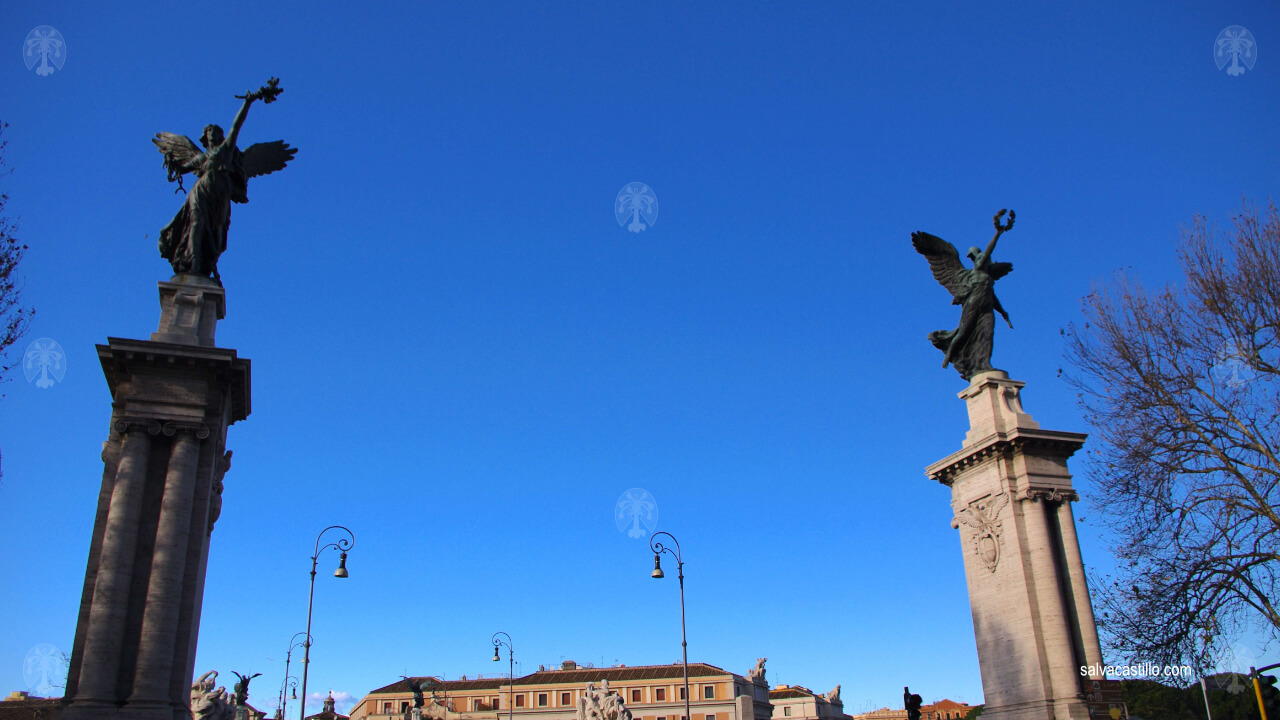
Cestio bridge: one of the oldest bridges in Rome. Originally built in the first century B.C. during the period of the Roman Republic, under the rule of the consul C. Cestius. The bridge has a symbolic and practical relationship with the Tiber Island, which since ancient times has been a place associated with medicine and religion. Important buildings, such as the ancient Temple of Aesculapius, are located on the island.

Fabricio bridge and Emilio bridge: The Fabricius bridge (also known as Ponte dei Quattro Capi) is the oldest bridge in Rome still in operation. It was built in 62 BC, during the rule of Lucius Fabricius, a Roman quaestor who oversaw its construction. The Emilio bridge, also known as Ponte di San Bartolomeo, was originally built in the 2nd century BC and was dedicated to Emilio Lepido. Only one arch remains standing.

Umberto I bridge and the Palazzo della Corte di Cassazione: inaugurated in 1909, the Umberto I bridge was designed in neoclassical style and named after King Umberto I, who was monarch of Italy from 1878 until his assassination in 1900. King Umberto was very popular in his time and was identified with the stability of the Kingdom of Italy.

Giardino degli Aranci
The Giardino degli Aranci (Garden of Oranges) is located on the Aventine Hill, one of the seven hills that form the historic core of the city. It offers a breathtaking panoramic view of the city.

The Tiber River has always been the backbone of Rome, and the dome of St. Peter’s Cathedral is omnipresent.

Rome is known as the “Eternal City” due to its rich history and legacy that has endured throughout the centuries. The city was founded in 753 B.C. by Romulus and Remus -according to legend- and has been the center of power, culture and religion at various times. The term “Eternal City” originated at the time of the Roman Empire, when the city was in full expansion and the belief that Rome would last forever was consolidated. The Latin poet Albius Tibullus coined the expression “Urbs Aeterna” (eternal city) in his book Elegies.
Of the great European capitals I have visited, Rome has impressed me with its cultural exuberance. Literally any cobblestone has epics to tell us if we pay enough attention to it. Paris, London or Madrid itself are unparalleled in terms of “concentrated” cultural wealth: the British Museum, the Louvre or the Prado are singularities in the fabric of space-time that transport us to other times when we visit them. But in addition to the Vatican Museums, in Rome culture is “scattered”, if I may say so. It is non-stop. This undoubtedly has to do with the several centuries of advantage that Rome has over these other capitals in terms of relevance at the “world” level. I suppose that Cairo or Baghdad must also generate that impression.

Rome began as a small city-state in the central region of the Italian peninsula. Over the centuries, the city grew in power and territory, changing from a monarchy to a republic in 509 BC. During the Roman Republic, Rome expanded its influence throughout what is now Italy and beyond, thanks to a series of military victories, strategic alliances and a system of government that, although initially republican, gradually centralized around figures such as Gaius Julius Caesar. In 27 BC, Caesar Augustus became the first emperor, marking the beginning of the Roman Empire.
The Roman Empire reached its peak in the 1st and 2nd centuries AD, extending its dominion from the British Isles to North Africa, and from Hispania to Asia Minor. However, over time, the empire began to face internal problems, such as economic crises, barbarian invasions and power struggles. In 476 AD, the Western Roman Empire fell due to pressure from Germanic peoples, while the Eastern Roman Empire, known as the Byzantine Empire, lasted until 1453.
Trastevere
Trastevere is a picturesque neighborhood of Rome, known for its bohemian atmosphere, narrow cobblestone streets, and lively nightlife. It is located south of the Tiber River, in the western part of the city, and its name, which comes from the Latin “trans Tiberim” (beyond the Tiber) indicates that it is on the other side of the river from the city center. My dear friend JLLV hosted us in his apartment and played Cicero when he had the chance.

The dome of St. Peter’s Cathedral of the Vatican dominates the skies of Rome. Around a corner one comes across beautiful pictures that make Rome a city of nooks and crannies.

Walking the Old City Center
Via Giulia is one of the most elegant and emblematic streets in the historic center of Rome, built in the sixteenth century under the papacy of Julius II, who commissioned the creation of this road to improve circulation in the city and beautify the area. The street was designed by the architect Antonio da Sangallo the Younger and is known for its Renaissance style, with palatial buildings of great prestige, elegant facades and a rectilinear layout that contrasts with the winding and more chaotic streets of Rome. One of the highlights of Via Giulia is the Farnese Arch, a small and beautiful triumphal arch dating back to the 16th century. This arch was built in honor of Pope Paolo III Farnese, who belonged to the powerful Farnese family, one of the most influential families in Rome during the Renaissance.

The Temple of Juturna (in Italian, Tempio di Giuturna) is an ancient Roman temple dedicated to Juturna, the goddess of fountains and springs. It was located in the Roman Forum, near the Forum Lake, southwest of the Curia (the building where the Senate and the Roman magistrates met), in an area that was related to water and water resources of the city.


Campo de’ Fiori is one of the most famous and vibrant squares in Rome, known for its open-air market and lively atmosphere. It is located in the heart of Rome’s historic center, near the Trastevere district.


In the center of the square stands a statue of Giordano Bruno, a 16th century Italian philosopher and priest who was burned at the stake by the Inquisition in 1600 because of his heretical ideas. The monument is a symbol of freedom of thought and the fight against religious intolerance. The statue of Bruno, facing the Vatican, is a reminder of his tragic fate and his defiance of the ecclesiastical power of the time.
Castel Sant’Angelo
The Castel Sant’Angelo (Castel Sant’Angelo) is one of my favorite monuments in Rome. Aesthetically it is a beautiful crenellated castle and its circular plan makes it unique to the eye.

Located on the banks of the Tiber River, near the Vatican, its history and architecture have transformed this building into a mixture of fortress, papal residence and museum.


Originally, the building was designed as an imperial mausoleum for Emperor Hadrian and his family in 135 AD. The Ponte Sant’Angelo was originally built in 134 AD.

During the Renaissance, the bridge was renovated and embellished, especially in 1669 under the papacy of Clement IX. It was at this time that the 10 statues of angels, the work of prominent sculptors of the time, such as Lorenzo Ottoni, Bernini and others, that adorn the bridge were added. These statues represent angels holding different elements of the passion of Christ, such as the cross, the nails or the crown of thorns.

The name “Castel Sant’Angelo” comes from a 6th century legend, according to which Pope Gregory I had a vision of the Archangel Michael above the castle, who, spreading his wings, announced the end of the plague that was ravaging Rome. This vision was interpreted as a sign of divine protection, and the castle was renamed “Castel Sant’Angelo” in honor of the Archangel Michael.

In its original phase, the mausoleum had a circular plan (cylindrical in shape), with a large square base surrounded by a circular wall and a series of columns. This plan was typical of Roman imperial tombs.

Over the centuries, especially during the papacy of Gregory I in the 6th century, the castle was modified to serve as a military fortress.

The building was fortified and turned into a papal refuge, with the addition of exterior walls and defensive structures. Inside there are several passages and corridors with ramps to allow the rapid movement of troops and weapons.


The parade ground houses several sculptures and a huge crossbow -like the dragon slayers that appear in Game of Thrones 😉-.


In the Museum of Castel Sant’Angelo I saw an exhibition of Renaissance weapons with delicate carvings. Some of these weapons are ceremonial, and sometimes belonged to the Swiss Guard – the Pope’s traditional protective guard.


Inside the Castel Sant’Angelo are the remains of Hadrian and his successors, including the Empress Sabina. In its early years it served to house the remains of the members of the Antonine dynasty.

In the Urn Hall, you can see several funerary urns that were used to keep the ashes of the emperors and other members of the imperial family. These urns were decorated with motifs and sculptures representing the imperial glory and power of the dynasty. The use of urns was a Roman tradition for the treatment of the remains of emperors and important figures.


From the top floor there is a beautiful view of Rome.



Castel Sant’Angelo has a direct connection to the Vatican through a subway passage known as the Passetto di Borgo. This passage, which was built in the 16th century, is one of the most fascinating elements of the castle’s history. It was a security measure for the popes, who, especially during periods of conflict and crisis, needed a quick and safe means of escape from the Vatican to the fortress.

The terrace of the castle, where the statue of the Archangel Michael is located, offers a spectacular panoramic view of Rome, including St. Peter’s Square, the Vatican, the Tiber River and other emblematic parts of the city. It is accessed by a narrow passage of stairs.

The statue of the Archangel Michael with a sword symbolizes the protection of Rome and the Papacy.

Through this figure, the archangel is associated with the power of the papacy to defend Rome and its inhabitants, especially in times of crisis or invasion.

This moment of seeing the statue of St. Michael on a clear night, when the flow of tourists – by chance – on the terrace had momentarily ceased, is a great moment in my life.
Arco de Constantino
The Arch of Constantine was inaugurated in 315 AD to commemorate the victory of Constantine I over Maxentius in the battle of the Milvian Bridge (312 AD), which consolidated Constantine’s power as emperor.

This victory was key, as it marked the beginning of the conversion of the Roman Empire to Christianity under the Edict of Milan in 313 A.D., which guaranteed religious freedom throughout the empire.

The panels of the arch are decorated with sculptural reliefs depicting scenes of Constantine’s victory over Maxentius, including battles, triumphal processions and scenes of Constantine’s acclamation as emperor.


The arch is strategically located between two of Rome’s most important monuments, the Colosseum and the Palatine Hill, and is one of the largest triumphal arches in the city. The arch is 21 meters high, 25.7 meters wide and 7.4 meters deep.

Near the Arch I found a group of soldiers of the Imperial Army of Rome doing parodic representations, very funny.
Trajan’s Column
Trajan’s Column (in Italian, Colonna Traiana) is one of the most important monuments of ancient Rome and stands as a symbol of the greatness of the emperor Trajan and his military success. It is located in the Forum of Trajan, in the heart of ancient Rome, near today’s Piazza Venezia.


The column was erected in 113 A.D., by order of Emperor Trajan, to commemorate his victory in the Dacia Wars (101-102 and 105-106 A.D.), which were fundamental for the expansion of the Roman Empire in the region of Dacia (now part of Romania).

The most distinctive feature of Trajan’s Column are the continuous reliefs that cover its surface, which recount Trajan’s military campaign in Dacia. The relief begins at the base of the column and spirals up to the top, in a frieze 200 meters long, and is composed of approximately 2,500 figures.

The column has a height of 38 meters from base to top. It is built in Carrara marble, one of the most appreciated materials of the time. At the base of the column is a sarcophagus containing the remains of Trajan.

Roma and the Tiber river
The Tiber River (in Latin, Tiberis) is one of the most important geographical elements of the city of Rome and has played a crucial role in both the founding and historical development of the capital of the Roman Empire.

According to Roman legend, Rome was founded by Romulus and Remus, the mythical twins who were suckled by a she-wolf on the banks of the Tiber. This story is associated with the Palatine Hill, one of Rome’s seven mountains, which lies right next to the river. In Roman mythology, the river was associated with the god Tiberino, who personified the river itself. The Romans worshipped Tiberinus as a protective deity of the city, and his cult was especially important during the early centuries of the Republic. Intrinsically associated with the river, which meanders through the city, are its bridges.
Giuseppe Mazzini bridge: inaugurated in 1906 and dedicated to this important Italian politician, philosopher and activist, one of the main leaders of the Italian unification movement and defender of republican and democratic ideals.

Vittorio Emanuele II bridge: connects the Vatican district with the city center. Inaugurated in 1911, its construction was carried out to commemorate the first king of Italy, Vittorio Emanuele II, and symbolizes the unity of the country after the Italian unification in the nineteenth century.

Cestio bridge: one of the oldest bridges in Rome. Originally built in the first century B.C. during the period of the Roman Republic, under the rule of the consul C. Cestius. The bridge has a symbolic and practical relationship with the Tiber Island, which since ancient times has been a place associated with medicine and religion. Important buildings, such as the ancient Temple of Aesculapius, are located on the island.

Fabricio bridge and Emilio bridge: The Fabricius bridge (also known as Ponte dei Quattro Capi) is the oldest bridge in Rome still in operation. It was built in 62 BC, during the rule of Lucius Fabricius, a Roman quaestor who oversaw its construction. The Emilio bridge, also known as Ponte di San Bartolomeo, was originally built in the 2nd century BC and was dedicated to Emilio Lepido. Only one arch remains standing.

Umberto I bridge and the Palazzo della Corte di Cassazione: inaugurated in 1909, the Umberto I bridge was designed in neoclassical style and named after King Umberto I, who was monarch of Italy from 1878 until his assassination in 1900. King Umberto was very popular in his time and was identified with the stability of the Kingdom of Italy.

Giardino degli Aranci
The Giardino degli Aranci (Garden of Oranges) is located on the Aventine Hill, one of the seven hills that form the historic core of the city. It offers a breathtaking panoramic view of the city.

The Tiber River has always been the backbone of Rome, and the dome of St. Peter’s Cathedral is omnipresent.

Optional: listen text-to-speech using the voices already in your device
This feature makes use of the Text-To-Speech capability as you have it already installed and configured on your own device. You will see that there are some voices that are not so good, choose from the list if you have a chance.
Rome is known as the “Eternal City” due to its rich history and legacy that has endured throughout the centuries. The city was founded in 753 B.C. by Romulus and Remus -according to legend- and has been the center of power, culture and religion at various times. The term “Eternal City” originated at the time of the Roman Empire, when the city was in full expansion and the belief that Rome would last forever was consolidated. The Latin poet Albius Tibullus coined the expression “Urbs Aeterna” (eternal city) in his book Elegies.
Of the great European capitals I have visited, Rome has impressed me with its cultural exuberance. Literally any cobblestone has epics to tell us if we pay enough attention to it. Paris, London or Madrid itself are unparalleled in terms of “concentrated” cultural wealth: the British Museum, the Louvre or the Prado are singularities in the fabric of space-time that transport us to other times when we visit them. But in addition to the Vatican Museums, in Rome culture is “scattered”, if I may say so. It is non-stop. This undoubtedly has to do with the several centuries of advantage that Rome has over these other capitals in terms of relevance at the “world” level. I suppose that Cairo or Baghdad must also generate that impression.

Rome began as a small city-state in the central region of the Italian peninsula. Over the centuries, the city grew in power and territory, changing from a monarchy to a republic in 509 BC. During the Roman Republic, Rome expanded its influence throughout what is now Italy and beyond, thanks to a series of military victories, strategic alliances and a system of government that, although initially republican, gradually centralized around figures such as Gaius Julius Caesar. In 27 BC, Caesar Augustus became the first emperor, marking the beginning of the Roman Empire.
The Roman Empire reached its peak in the 1st and 2nd centuries AD, extending its dominion from the British Isles to North Africa, and from Hispania to Asia Minor. However, over time, the empire began to face internal problems, such as economic crises, barbarian invasions and power struggles. In 476 AD, the Western Roman Empire fell due to pressure from Germanic peoples, while the Eastern Roman Empire, known as the Byzantine Empire, lasted until 1453.
Trastevere
Trastevere is a picturesque neighborhood of Rome, known for its bohemian atmosphere, narrow cobblestone streets, and lively nightlife. It is located south of the Tiber River, in the western part of the city, and its name, which comes from the Latin “trans Tiberim” (beyond the Tiber) indicates that it is on the other side of the river from the city center. My dear friend JLLV hosted us in his apartment and played Cicero when he had the chance.

The dome of St. Peter’s Cathedral of the Vatican dominates the skies of Rome. Around a corner one comes across beautiful pictures that make Rome a city of nooks and crannies.

Walking the Old City Center
Via Giulia is one of the most elegant and emblematic streets in the historic center of Rome, built in the sixteenth century under the papacy of Julius II, who commissioned the creation of this road to improve circulation in the city and beautify the area. The street was designed by the architect Antonio da Sangallo the Younger and is known for its Renaissance style, with palatial buildings of great prestige, elegant facades and a rectilinear layout that contrasts with the winding and more chaotic streets of Rome. One of the highlights of Via Giulia is the Farnese Arch, a small and beautiful triumphal arch dating back to the 16th century. This arch was built in honor of Pope Paolo III Farnese, who belonged to the powerful Farnese family, one of the most influential families in Rome during the Renaissance.

The Temple of Juturna (in Italian, Tempio di Giuturna) is an ancient Roman temple dedicated to Juturna, the goddess of fountains and springs. It was located in the Roman Forum, near the Forum Lake, southwest of the Curia (the building where the Senate and the Roman magistrates met), in an area that was related to water and water resources of the city.


Campo de’ Fiori is one of the most famous and vibrant squares in Rome, known for its open-air market and lively atmosphere. It is located in the heart of Rome’s historic center, near the Trastevere district.


In the center of the square stands a statue of Giordano Bruno, a 16th century Italian philosopher and priest who was burned at the stake by the Inquisition in 1600 because of his heretical ideas. The monument is a symbol of freedom of thought and the fight against religious intolerance. The statue of Bruno, facing the Vatican, is a reminder of his tragic fate and his defiance of the ecclesiastical power of the time.
Castel Sant’Angelo
The Castel Sant’Angelo (Castel Sant’Angelo) is one of my favorite monuments in Rome. Aesthetically it is a beautiful crenellated castle and its circular plan makes it unique to the eye.

Located on the banks of the Tiber River, near the Vatican, its history and architecture have transformed this building into a mixture of fortress, papal residence and museum.


Originally, the building was designed as an imperial mausoleum for Emperor Hadrian and his family in 135 AD. The Ponte Sant’Angelo was originally built in 134 AD.

During the Renaissance, the bridge was renovated and embellished, especially in 1669 under the papacy of Clement IX. It was at this time that the 10 statues of angels, the work of prominent sculptors of the time, such as Lorenzo Ottoni, Bernini and others, that adorn the bridge were added. These statues represent angels holding different elements of the passion of Christ, such as the cross, the nails or the crown of thorns.

The name “Castel Sant’Angelo” comes from a 6th century legend, according to which Pope Gregory I had a vision of the Archangel Michael above the castle, who, spreading his wings, announced the end of the plague that was ravaging Rome. This vision was interpreted as a sign of divine protection, and the castle was renamed “Castel Sant’Angelo” in honor of the Archangel Michael.

In its original phase, the mausoleum had a circular plan (cylindrical in shape), with a large square base surrounded by a circular wall and a series of columns. This plan was typical of Roman imperial tombs.

Over the centuries, especially during the papacy of Gregory I in the 6th century, the castle was modified to serve as a military fortress.

The building was fortified and turned into a papal refuge, with the addition of exterior walls and defensive structures. Inside there are several passages and corridors with ramps to allow the rapid movement of troops and weapons.


The parade ground houses several sculptures and a huge crossbow -like the dragon slayers that appear in Game of Thrones 😉-.


In the Museum of Castel Sant’Angelo I saw an exhibition of Renaissance weapons with delicate carvings. Some of these weapons are ceremonial, and sometimes belonged to the Swiss Guard – the Pope’s traditional protective guard.


Inside the Castel Sant’Angelo are the remains of Hadrian and his successors, including the Empress Sabina. In its early years it served to house the remains of the members of the Antonine dynasty.

In the Urn Hall, you can see several funerary urns that were used to keep the ashes of the emperors and other members of the imperial family. These urns were decorated with motifs and sculptures representing the imperial glory and power of the dynasty. The use of urns was a Roman tradition for the treatment of the remains of emperors and important figures.


From the top floor there is a beautiful view of Rome.



Castel Sant’Angelo has a direct connection to the Vatican through a subway passage known as the Passetto di Borgo. This passage, which was built in the 16th century, is one of the most fascinating elements of the castle’s history. It was a security measure for the popes, who, especially during periods of conflict and crisis, needed a quick and safe means of escape from the Vatican to the fortress.

The terrace of the castle, where the statue of the Archangel Michael is located, offers a spectacular panoramic view of Rome, including St. Peter’s Square, the Vatican, the Tiber River and other emblematic parts of the city. It is accessed by a narrow passage of stairs.

The statue of the Archangel Michael with a sword symbolizes the protection of Rome and the Papacy.

Through this figure, the archangel is associated with the power of the papacy to defend Rome and its inhabitants, especially in times of crisis or invasion.

This moment of seeing the statue of St. Michael on a clear night, when the flow of tourists – by chance – on the terrace had momentarily ceased, is a great moment in my life.
Arco de Constantino
The Arch of Constantine was inaugurated in 315 AD to commemorate the victory of Constantine I over Maxentius in the battle of the Milvian Bridge (312 AD), which consolidated Constantine’s power as emperor.

This victory was key, as it marked the beginning of the conversion of the Roman Empire to Christianity under the Edict of Milan in 313 A.D., which guaranteed religious freedom throughout the empire.

The panels of the arch are decorated with sculptural reliefs depicting scenes of Constantine’s victory over Maxentius, including battles, triumphal processions and scenes of Constantine’s acclamation as emperor.


The arch is strategically located between two of Rome’s most important monuments, the Colosseum and the Palatine Hill, and is one of the largest triumphal arches in the city. The arch is 21 meters high, 25.7 meters wide and 7.4 meters deep.

Near the Arch I found a group of soldiers of the Imperial Army of Rome doing parodic representations, very funny.
Trajan’s Column
Trajan’s Column (in Italian, Colonna Traiana) is one of the most important monuments of ancient Rome and stands as a symbol of the greatness of the emperor Trajan and his military success. It is located in the Forum of Trajan, in the heart of ancient Rome, near today’s Piazza Venezia.


The column was erected in 113 A.D., by order of Emperor Trajan, to commemorate his victory in the Dacia Wars (101-102 and 105-106 A.D.), which were fundamental for the expansion of the Roman Empire in the region of Dacia (now part of Romania).

The most distinctive feature of Trajan’s Column are the continuous reliefs that cover its surface, which recount Trajan’s military campaign in Dacia. The relief begins at the base of the column and spirals up to the top, in a frieze 200 meters long, and is composed of approximately 2,500 figures.

The column has a height of 38 meters from base to top. It is built in Carrara marble, one of the most appreciated materials of the time. At the base of the column is a sarcophagus containing the remains of Trajan.

Roma and the Tiber river
The Tiber River (in Latin, Tiberis) is one of the most important geographical elements of the city of Rome and has played a crucial role in both the founding and historical development of the capital of the Roman Empire.

According to Roman legend, Rome was founded by Romulus and Remus, the mythical twins who were suckled by a she-wolf on the banks of the Tiber. This story is associated with the Palatine Hill, one of Rome’s seven mountains, which lies right next to the river. In Roman mythology, the river was associated with the god Tiberino, who personified the river itself. The Romans worshipped Tiberinus as a protective deity of the city, and his cult was especially important during the early centuries of the Republic. Intrinsically associated with the river, which meanders through the city, are its bridges.
Giuseppe Mazzini bridge: inaugurated in 1906 and dedicated to this important Italian politician, philosopher and activist, one of the main leaders of the Italian unification movement and defender of republican and democratic ideals.

Vittorio Emanuele II bridge: connects the Vatican district with the city center. Inaugurated in 1911, its construction was carried out to commemorate the first king of Italy, Vittorio Emanuele II, and symbolizes the unity of the country after the Italian unification in the nineteenth century.

Cestio bridge: one of the oldest bridges in Rome. Originally built in the first century B.C. during the period of the Roman Republic, under the rule of the consul C. Cestius. The bridge has a symbolic and practical relationship with the Tiber Island, which since ancient times has been a place associated with medicine and religion. Important buildings, such as the ancient Temple of Aesculapius, are located on the island.

Fabricio bridge and Emilio bridge: The Fabricius bridge (also known as Ponte dei Quattro Capi) is the oldest bridge in Rome still in operation. It was built in 62 BC, during the rule of Lucius Fabricius, a Roman quaestor who oversaw its construction. The Emilio bridge, also known as Ponte di San Bartolomeo, was originally built in the 2nd century BC and was dedicated to Emilio Lepido. Only one arch remains standing.

Umberto I bridge and the Palazzo della Corte di Cassazione: inaugurated in 1909, the Umberto I bridge was designed in neoclassical style and named after King Umberto I, who was monarch of Italy from 1878 until his assassination in 1900. King Umberto was very popular in his time and was identified with the stability of the Kingdom of Italy.

Giardino degli Aranci
The Giardino degli Aranci (Garden of Oranges) is located on the Aventine Hill, one of the seven hills that form the historic core of the city. It offers a breathtaking panoramic view of the city.

The Tiber River has always been the backbone of Rome, and the dome of St. Peter’s Cathedral is omnipresent.
